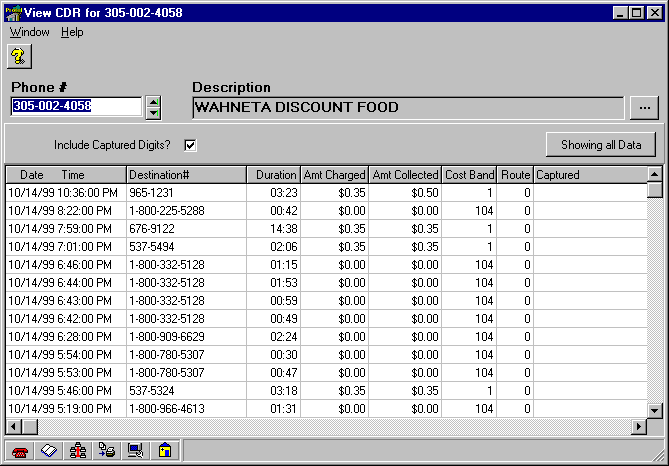View CDR
The View CDR window displays detailed call records. There is one record for each completed call, and also one record for each incomplete call if option 198
ñ Record Incomplete Call in CDR is checked in the Miscellaneous tab of the Options window. CDR can be used for any purpose where detailed call information is needed, including long-distance billing and law enforcement assistance. Click on different areas of the picture below for pop-up descriptions; scroll down below the picture for more information.

To access the View CDR window, open the
Phone window by clicking on the Phones & Customers button in the Navigator or the Navbar. If the Phone window has not been chosen to open in the Preferences, then either the Quick View window or the Phone List window will appear. In either case, these windows may be used to find the desired phone record. Search records by field in the Quick View window, or search records by Location Name/Description field in the Phone List window. When either method is used, the Phone window will open with the desired phone record displayed. Simply click on the View CDR button and the CDR for that phone will be displayed. A different phone can be chosen from the View CDR window by choosing the desired record by the phone number pull-down menu or searching by the Location Name or Description field. Open this search window by clicking the ellipsis to the right of the Location Name or the Description field, whichever is displayed (use the preferences to specify either the Location Name or the Description). Under the ellipses is a button that opens a pull-down menu. The first part of the buttonís label is ìShowing.î What follows can be one of the following, each describing the date range of the results in the bottom of the window: 30 Days, 45 Days, 60 Days, 120 Days, 180 Days, All Days.
The information in the View CDR window includes the Date, Time, and Destination Number, Duration of the call, Amount Charged for the call, Amount Collected from the user,
Cost Band, Route, and Captured numbers of each call. Click the Include Captured Digits checkbox to display the numbers dialed after an 800, 888, 877, or 950 number. Captured Numbers may be blank if: no further digits were dialed after the call was completed, the Include Captured Digits checkbox was not checked, or the phone was not set to store the extra digits (set in the Miscellaneous tab in the Options window, the General tab of the Call Processing window, and/or the Edit Assigned Bands tab in the Cost window).
If option 1A5 is checked in the
Unassigned tab of the Options window (and the phone has been updated with this option), then the Call Type is recorded within the Call Detail Record. The advantage of this is that the Call Accounting window and the Call Accounting report break down the Coin Calls and 0+ calls by Call Type. If this option is not checked, the Call Accounting window (and report) list all Coin Calls by the subheading Miscellaneous, and lists 0+ calls under the Special Calls heading.
Another benefit of option 1A5, recording Call Type within the CDR, is that CDR can be collected from the phone by Call Type. This saves time during polling, which saves money. To do this, use the Collect CDR column in the
Call Processing window and select the Call Types that should be retrieved.
Note: Recording and collecting CDR by Call Type is only available when using
Y2k compliant firmware. Also, a properly configured Cost record is necessary to classify a call by Call Type. Cost files obtained from Protel and Protelís distributors contain the necessary information to take advantage of this useful and money-saving feature.
The information produced in this window is the same as that produced in the
Audit CDR report. To access the Audit CDR report, click the Reports button in the Navigator or the Navbar, then select the Audit CDR Report from the list.
Polling/Reporting options and instructions.